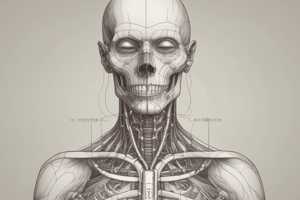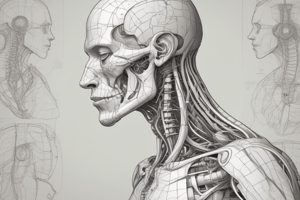Podcast
Questions and Answers
Which muscle helps in depression of the mandible?
Which muscle helps in depression of the mandible?
- Deltoid muscle
- Scalene muscle
- Sternocleiodomastoid muscle
- Platysma muscle (correct)
What is the origin of the sternocleiodomastoid muscle?
What is the origin of the sternocleiodomastoid muscle?
- Manubrium of the sternum
- Inferior border of the mandible
- Mastoid process of the temporal bone and nuchal line of the occipital bone (correct)
- Nuchal line of the occipital bone
Which nerve supplies the platysma muscle?
Which nerve supplies the platysma muscle?
- Cervical plexus
- CN VII (correct)
- CN XI
- Phrenic nerve
What is the function of the sternocleiodomastoid muscle when it acts alone?
What is the function of the sternocleiodomastoid muscle when it acts alone?
How many groups are the muscles of the neck divided into?
How many groups are the muscles of the neck divided into?
What is the insertion of the platysma muscle?
What is the insertion of the platysma muscle?
Which group of neck muscles includes the omotracheal triangle?
Which group of neck muscles includes the omotracheal triangle?
What is the main function of the superficial cervical fascia in the neck?
What is the main function of the superficial cervical fascia in the neck?
Which of the following is NOT a part of the anterior cervical region?
Which of the following is NOT a part of the anterior cervical region?
What is the name of the triangle that includes the omotracheal triangle and the carotid triangle?
What is the name of the triangle that includes the omotracheal triangle and the carotid triangle?
Which of the following is a part of the deep cervical fascia?
Which of the following is a part of the deep cervical fascia?
How many major groups of muscles are in the neck?
How many major groups of muscles are in the neck?
What is the common function of the scalenus anterior, scalenus medius, and scalenus posterior muscles?
What is the common function of the scalenus anterior, scalenus medius, and scalenus posterior muscles?
Which of the following vertebrae is NOT an origin of the scalenus anterior muscle?
Which of the following vertebrae is NOT an origin of the scalenus anterior muscle?
What is the common innervation of the scalenus anterior, scalenus medius, and scalenus posterior muscles?
What is the common innervation of the scalenus anterior, scalenus medius, and scalenus posterior muscles?
What is the insertion of the scalenus posterior muscle?
What is the insertion of the scalenus posterior muscle?
What is the function of the scalenus anterior muscle in breathing?
What is the function of the scalenus anterior muscle in breathing?
Which of the following tissue spaces of the neck lies between the investing layer of the deep cervical fascia and the pretracheal fascia?
Which of the following tissue spaces of the neck lies between the investing layer of the deep cervical fascia and the pretracheal fascia?
Flashcards are hidden until you start studying
Study Notes
Regions of the Neck
- The neck is divided into regions: anterior cervical region (or anterior cervical triangle), submandibular triangle, carotid triangle, muscular triangle (or omotracheal triangle), submental triangle, and lateral cervical region
Fascia of the Neck
- The neck has superficial and deep cervical fascia
- The deep cervical fascia condenses to form the carotid sheath, which encloses the internal jugular vein, common and internal carotid artery, and vagus nerve
Muscles of the Neck
- The 16 muscles of the neck are divided into anterior, middle, and posterior groups
- Anterior group:
- Platysma muscle: originates from the inferior border of the mandible, fascia, and skin of the face; inserts into the fascia and skin over the great pectoral and deltoid muscles; functions to tense the skin of the neck and assist in depressing the mandible
- Sternocleidomastoid muscle: originates from the mastoid process of the temporal bone and nuchal line of the occipital bone; inserts into the manubrium of the sternum; functions to turn the face superiorly towards the opposite side and flex the neck
Middle Group Muscles
- Scalenus anterior: originates from the transverse processes of the C3 and C6 vertebrae; inserts into the tubercle on the superior surface of the first rib; functions to elevate the first rib, flex the neck laterally, and play a role in breathing
- Scalenus medius: originates from the transverse processes of the C2 and C7 vertebrae; inserts into the superior surface of the first rib; functions to elevate the first rib and flex the neck laterally
- Scalenus posterior: originates from the transverse processes of the C2 and C7 vertebrae; inserts into the external surface of the second rib; functions to elevate the second rib and flex the neck laterally
Fasciae and Tissue Spaces of the Neck
- Divided into three compartments: anterior, middle, and posterior tissue spaces
- Anterior tissue space lies between the investing layer of the deep cervical fascia and the pretracheal fascia
- Middle tissue space is a visceral compartment between the pretracheal and prevertebral fascia
Studying That Suits You
Use AI to generate personalized quizzes and flashcards to suit your learning preferences.





